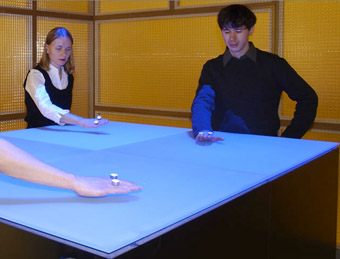Because I currently work at CNSI as an undergraduate researcher, I can really relate to this week's lecture about nanotechnology. However, even though I am aware of the boundless applications of nanotechnology to medicine, I was quite astonished to find out that nanotechnology can has also led to advancements in art, as seen in the Nano-Scape.
A beautiful image of California Nanosystems Technology(CNSI) is shown above, and it is home to many of the world's strongest and modern microscopes, including the STEM, cryo-EM, cryo-ET, and AFM microscopes. A link of the Titan Krios microscope constructed by FEI in CNSI and assembled by my research advisor: http://www.eicn.ucla.edu/titanbuildup.
Massive advancements in medicine has allowed for for massive growth in nanotechnology. One such application can be seen in the research of how nanotechnology from diesel exhaust and damage lung airway cells. As diesel exhaust particles, a major part of urban smog, deliver organic chemicals onto the cilia on our lungs, researching ways to combat this growing problem, especially in suburban areas, could greatly benefit humans. This finding could eventually lead to new therapies for people susceptible to the disease. Shown below are the diesel exhaust particles, consisted of a carbon core and coated with organic chemicals and metals.
 |
| Diesel Exhaust Particles |
On the other hand, nanotechnology has also paved the way for advancements in art. Through the process of microscopic manipulations, the Nano-Scape, shown below, allows people to experience the nano-world touch by utilizing magnetics. The magnetic field creates constantly shifting forces, which is stimulated by movements from the user's hands that cause all the atoms in the array to interact in a constant readjustment of their proximity to one another. This constant movement allows for users of the Nano-Scape to create an ever "changing invisible sculpture."
 |
| Nano-Scape |
Professor Gimzewski notes in this week's lecture that one of the most impactful ways of using nanotechnology is through medicine. I agree wholeheartedly with this statement, as most of the time with our bodies, we don't know something is actually wrong with our bodies until we go to the doctor. But at the same time, using nanotechnology for art also allows us to experience art in another dimension and at another scale.
Citations:
Dawkins, Urszula. "realtime 96." RealTime Arts. N.p., 30 May 2010. Web. 24 Nov. 2013. <http://www.realtimearts.net/article/96/9816>.
Feinknopf, Brad. Suspended Walkways at CNSI. 2007. Vinoly's CNSI, University of Los Angeles California. The Architect's Newspaper. Web. 24 Nov. 2013.
"Findings on Pollution Damage to Human Airways Could Yield Novel Therapies." - DukeHealth.org. Duke University, 18 Jan. 2011. Web. 24 Nov. 2013.
<http://www.dukehealth.org/health_library/news/findings-on-pollution-damage-to-human-airways-could-yield-novel-therapies?utm_source=dukehealth.org&utm_medium=rss&utm_campaign=RSS_news>.
"Nanotech Jim pt1." YouTube. YouTube, 21 May 2012. Web. 24 Nov. 2013. <https://www.youtube.com/watch?v=q7jM6-iqzzE>.
Sommerer, Christa . Nano-Scape. 2010. John Curtin Gallery, Australia. Art in the Age of NanoTechnology. Web. 24 Nov. 2013.
Zhou, Hong. "The building of the Titan Krios | Electron Imaging Center for Nanomachines." The building of the Titan Krios | Electron Imaging Center for Nanomachines. N.p., 10 Aug. 2006. Web. 24 Nov. 2013. <http://www.eicn.ucla.edu/titanbuildup>.



























